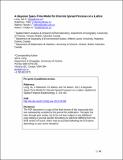Files in this item
A Bayesian space-time model for discrete spread processes on a lattice
Item metadata
| dc.contributor.author | Long, J.A. | |
| dc.contributor.author | Nelson, T.A. | |
| dc.contributor.author | Robertson, Colin | |
| dc.contributor.author | Nathoo, F.S. | |
| dc.date.accessioned | 2014-09-16T16:01:03Z | |
| dc.date.available | 2014-09-16T16:01:03Z | |
| dc.date.issued | 2012-06-01 | |
| dc.identifier | 69223440 | |
| dc.identifier | f662e160-283d-4a6f-9dab-748604e18d8e | |
| dc.identifier | 84861926682 | |
| dc.identifier.citation | Long , J A , Nelson , T A , Robertson , C & Nathoo , F S 2012 , ' A Bayesian space-time model for discrete spread processes on a lattice ' , Spatial and Spatio-temporal Epidemiology , vol. 3 , no. 2 , pp. 151-162 . https://doi.org/10.1016/j.sste.2012.04.008 | en |
| dc.identifier.issn | 1877-5845 | |
| dc.identifier.uri | https://hdl.handle.net/10023/5418 | |
| dc.description | Funding for this work was provided by GEOIDE through the Government of Canada’s Networks for Centres of Excellence program. | en |
| dc.description.abstract | In this article we present a Bayesian Markov model for investigating environmental spread processes. We formulate a model where the spread of a disease over a heterogeneous landscape through time is represented as a probabilistic function of two processes: local diffusion and random-jump dispersal. This formulation represents two mechanisms of spread which result in highly peaked and long-tailed distributions of dispersal distances (i.e., local and long-distance spread), commonly observed in the spread of infectious diseases and biological invasions. We demonstrate the properties of this model using a simulation experiment and an empirical case study - the spread of mountain pine beetle in western Canada. Posterior predictive checking was used to validate the number of newly inhabited regions in each time period. The model performed well in the simulation study in which a goodness-of-fit statistic measuring the number of newly inhabited regions in each time interval fell within the 95% posterior predictive credible interval in over 97% of simulations. The case study of a mountain pine beetle infestation in western Canada (1999-2009) extended the base model in two ways. First, spatial covariates thought to impact the local diffusion parameters, elevation and forest cover, were included in the model. Second, a refined definition for translocation or jump-dispersal based on mountain pine beetle ecology was incorporated improving the fit of the model. Posterior predictive checks on the mountain pine beetle model found that the observed goodness-of-fit test statistic fell within the 95% posterior predictive credible interval for 8 out of 10. years. The simulation study and case study provide evidence that the model presented here is both robust and flexible; and is therefore appropriate for a wide range of spread processes in epidemiology and ecology. | |
| dc.format.extent | 12 | |
| dc.format.extent | 1127148 | |
| dc.language.iso | eng | |
| dc.relation.ispartof | Spatial and Spatio-temporal Epidemiology | en |
| dc.rights | © 2012. Elsevier Inc. All rights reserved. This is the author’s version of a work that was accepted for publication in Spatial and Spatio-temporal Epidemiology. Changes resulting from the publishing process, such as peer review, editing, corrections, structural formatting, and other quality control mechanisms may not be reflected in this document. Changes may have been made to this work since it was submitted for publication. A definitive version was subsequently published in Spatial and Spatio-temporal Epidemiology, 3, June 2012 DOI 10.1016/j.sste.2012.04.008 | en |
| dc.subject | G Geography (General) | en |
| dc.subject | QD Chemistry | en |
| dc.subject | SDG 3 - Good Health and Well-being | en |
| dc.subject.lcc | G1 | en |
| dc.subject.lcc | QD | en |
| dc.title | A Bayesian space-time model for discrete spread processes on a lattice | en |
| dc.type | Journal article | en |
| dc.contributor.institution | University of St Andrews.Geography & Sustainable Development | en |
| dc.contributor.institution | University of St Andrews.Centre for Geoinformatics | en |
| dc.contributor.institution | University of St Andrews.Bell-Edwards Geographic Data Institute | en |
| dc.identifier.doi | 10.1016/j.sste.2012.04.008 | |
| dc.description.status | Peer reviewed | en |
This item appears in the following Collection(s)
Items in the St Andrews Research Repository are protected by copyright, with all rights reserved, unless otherwise indicated.

